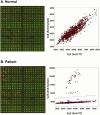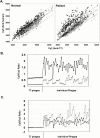Using protein microarray as a diagnostic assay for non-small cell lung cancer
- PMID: 16109979
- PMCID: PMC2718416
- DOI: 10.1164/rccm.200505-830OC
Using protein microarray as a diagnostic assay for non-small cell lung cancer
Abstract
Rationale: Phenotypic and genotypic heterogeneity of lung cancer likely precludes the identification of a single predictive marker and suggests the importance of identifying and measuring multiple markers.
Objectives: We describe the use of a fluorescent protein microarray to identify and measure multiple non-small cell lung cancer-associated antibodies and show how simultaneous measurements can be combined into a single diagnostic assay.
Methods: T7 phage cDNA libraries of non-small cell lung cancer were first biopanned with plasma samples from normal subjects and patients with non-small cell lung cancer to enrich the component of tumor-associated proteins, and then applied to microarray slides. Two hundred twelve immunogenic phage-expressed proteins were identified from roughly 4,000 clones, using high-throughput screening with patient plasmas and assayed with 40 cancer and 41 normal plasma samples. Twenty patient and 21 normal plasma samples were randomly chosen and used for statistical determination of the predictive value of each putative marker. Statistical analysis identified antibody reactivity to seven unique phage-expressed proteins that were significantly different (p < 0.01) between patient and normal groups. The remaining 20 patient and 20 normal plasma samples were used as an independent test of the predictive ability of the selected markers.
Main results: Measurements of the 5 most predictive phage proteins were combined in a logistic regression model that achieved 90% sensitivity and 95% specificity in prediction of patient samples, whereas leave-one-out statistical analysis achieved 88.9% diagnostic accuracy among all 81 samples.
Conclusion: Our data indicate that antibody profiling is a promising approach that could achieve high diagnostic accuracy for non-small cell lung cancer.
Figures


References
-
- Hoffman PC, Mauer Am, Vokes EE. Lung cancer. Lancet 2000;5:479–485. - PubMed
-
- Niklinski J, Furman M. Clinical tumour markers in lung cancer. Eur J Cancer Prev 1995;4:129–138. - PubMed
-
- Ferrigno D, Buccheri G, Biggi A. Serum tumour markers in lung cancer: history, biology and clinical applications. Eur Respir J 1994;7:186–197. - PubMed
-
- Gure AO, Altorki NK, Stockert E, Scanlan MJ, Old LJ, Chen YT. Human lung cancer antigens recognized by autologous antibodies: definition of a novel cDNA derived from the tumor suppressor gene locus on chromosome 3p21.3. Cancer Res 1998;58:1034–1041. - PubMed
Publication types
MeSH terms
Substances
Grants and funding
LinkOut - more resources
Full Text Sources
Other Literature Sources
Medical

